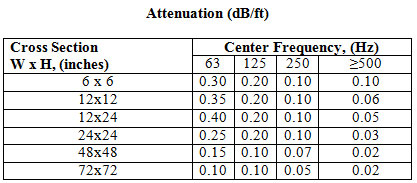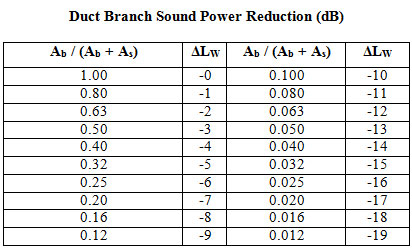Noise Reduction in HVAC Duct Systems
Natural Attenuation
Single-wall duct system components provide natural sound attenuation. Several mechanisms such as duct wall losses, elbow reflections, sound power splits and terminal end reflections may serve to provide significant natural attenuation sufficient to reduce noise levels to acceptable limits. Natural attenuation could also eliminate the need for expensive energy consuming supplemental products and should be the first step in acoustically analyzing a duct system.
In-duct Single Wall Duct Attenuation
When sound travels through a duct system, some of the sound energy is transmitted to the duct surface. This will cause that duct surface to vibrate and dissipate some of the sound energy. The amount of energy dissipated through the walls of a duct is a function of the shape, size, length and the frequency of the sound.
The reduction of in-duct sound energy, which is dissipated through natural duct attenuation is expressed in units of (dB/ft). Long duct lengths have significant amounts of attenuated sound energy.
Natural duct attenuation assumes that the duct walls are massive enough to contain most of the in-duct noise. Also, that the sound energy is transferred to the duct surface and converted into vibration of the duct wall material. See the following two tables for natural sound attenuation through round and rectangular ducts.
Table 11. Natural attenuation-straight circular sheet metal duct.
 |
|
Table courtesy of Kinetics Noise Control, Inc. |
Table 12. Natural attenuation—unlined rectangular sheet metal duct.
 |
|
Table courtesy of Kinetics Noise Control, Inc. |
Elbow Attenuation– Reflection
When sound energy enters an elbow, part of the sound wave is attenuated through reflection. The amount of attenuation is proportional to the elbow bend angle and frequency of the sound. It is expressed in dB/elbow per frequency.
Table 13. Insertion Loss (attenuation) of Radiused Rectangular Elbows (dB)
 |
Sound Power Splits
The most significant mechanism of natural attenuation is sound power splits. Airborne sound power energy in watts behaves the same as air when approaching a divided-flow fitting—it divides or splits. The division of sound energy at a junction will be proportional to the cross-sectional area of the downstream path of the flow divided by the total of all the cross-sectional areas of the downstream flow paths.
For example, sound energy moving through a 12-in. common duct with a 5-in. branch and an 11-in. straight-through will be split into the following ratios: branch duct: 0.17; main duct: 0.83. Meaning that only 17 percent of the sound energy entering the fitting will propagate down the branch and the balance will travel straight-through.
Table 14. Natural attenuation sound power reduction.
 |
|
Provided by Kinetics Noise Control, Inc. |
Ab is branch cross-sectional area
As is the straight-through cross-sectional area (downstream)
Lw is sound power level in dBs.









